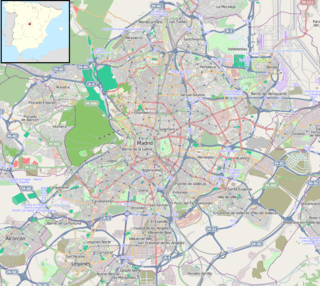Gran Vía (Madrid Metro)
Gran Vía is a station on Line 1 and Line 5 of the Madrid Metro, located underneath Gran Vía and Red de San Luis Plaza in the Centro district of Madrid. It is located in fare zone A.[1][2]
| Madrid Metro station | ||||||||||||||||
| Location | Centro, Madrid Spain | |||||||||||||||
| Coordinates | 40.4200103°N 3.7018052°W | |||||||||||||||
| Owned by | CRTM | |||||||||||||||
| Operated by | CRTM | |||||||||||||||
| Construction | ||||||||||||||||
| Disabled access | Under construction | |||||||||||||||
| Other information | ||||||||||||||||
| Fare zone | A | |||||||||||||||
| History | ||||||||||||||||
| Opened | 17 October 1919 | |||||||||||||||
| Rebuilt | 2019–2021 | |||||||||||||||
| Services | ||||||||||||||||
| ||||||||||||||||
| Location | ||||||||||||||||
 Gran Vía Location within Madrid | ||||||||||||||||
The station is currently closed for major renovations.
History
The station was opened in 1919 as one of the original 8 metro stops in Madrid. The original name of the station was Red de San Luis after the nearby plaza. The Gran Vía street was still under construction at that time, but a year later the station adopted that name.[3]
During the dictatorship of Franco, the name was changed again to José Antonio. This was done in parallel with the renaming of the Gran Vía street to José Antonio Avenue by Franco, in honor of José Antonio, founder of the fascist party Falange.
In 1970, the Line 5 platforms opened under the name José Antonio. Fourteen years later, in 1984, the station returned to its previous name of Gran Vía.
For many years, the station was known for the elaborate edifice that housed the elevators, built by the architect Antonio Palacios. It was constructed of polished granite with an iron and glass canopy. To use the elevator, customers had to pay a small fee. The original vestibule, also done by Palacios, was decorated with glazed tiles. When the edifice was dismantled in 1972, it was returned to O Porriño, the architect's hometown. There is currently a project underway to install a replica.
Current renovation works
The station is currently in the process of undergoing major renovations and physical expansions, which will include a pedestrian tunnel to the nearby Sol station, at an estimated cost of €18 million.[4][3] Following a number of significant delays, as of July 2020, the station is set to finally reopen 2021.[5]
Further reading
- Zozaya, María; Barrena, Clemente y Medrano, José Miguel, La Gran Vía, Real Academia de Bellas Artes de San Fernando, 2002, Madrid. (ISBN 84-87181-83-X).
References
- "Línea 1". Metro de Madrid. Retrieved 21 March 2020.
- "Línea 5". Metro de Madrid. Retrieved 6 September 2019.
- Medialdea, Sara (11 October 2017). "Así será la nueva estación de Gran Vía de Madrid" (in Spanish). ABC Madrid.
- "Cifuentes se gastará 300 millones de euros en conectar Sol con Gran Vía y ampliar la línea 11 de metro" (in Spanish). El Diario. 21 September 2017.
- "La estación de Metro de Gran Vía reabrirá en 2021" (in Spanish). madridiario. 6 July 2020. Retrieved 7 July 2020.